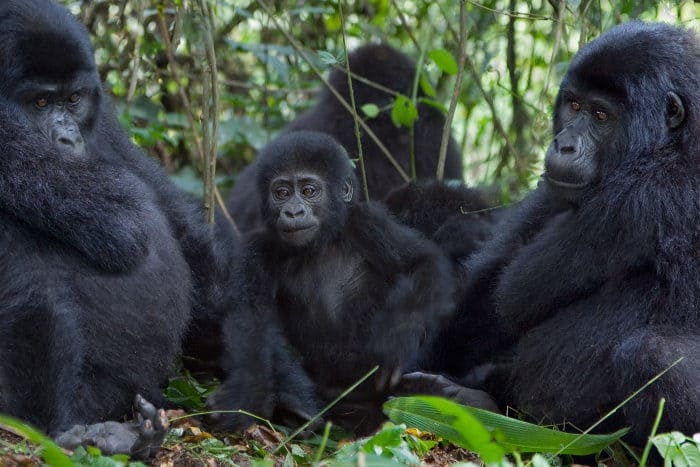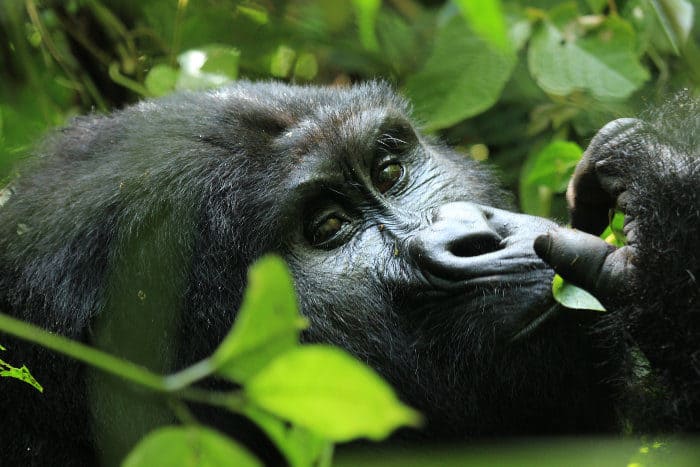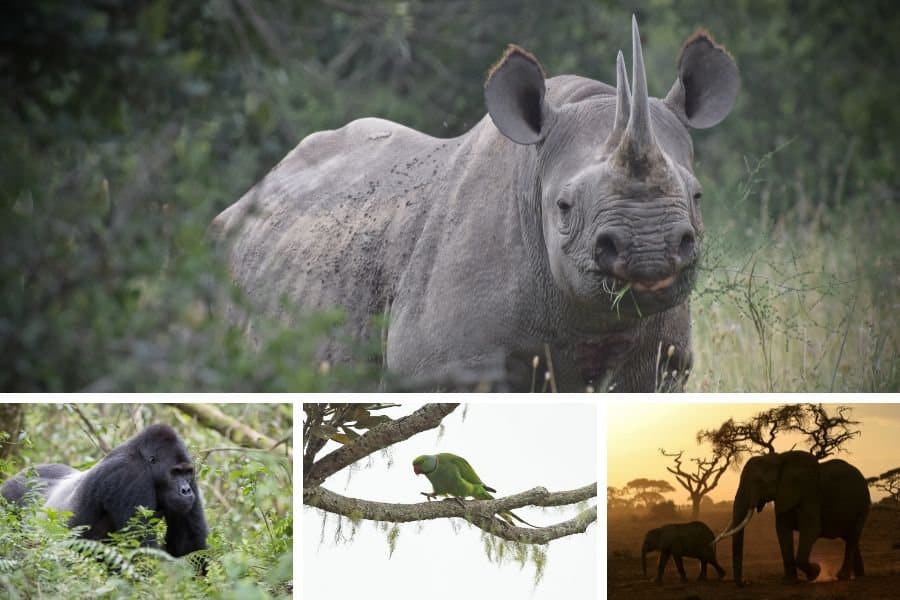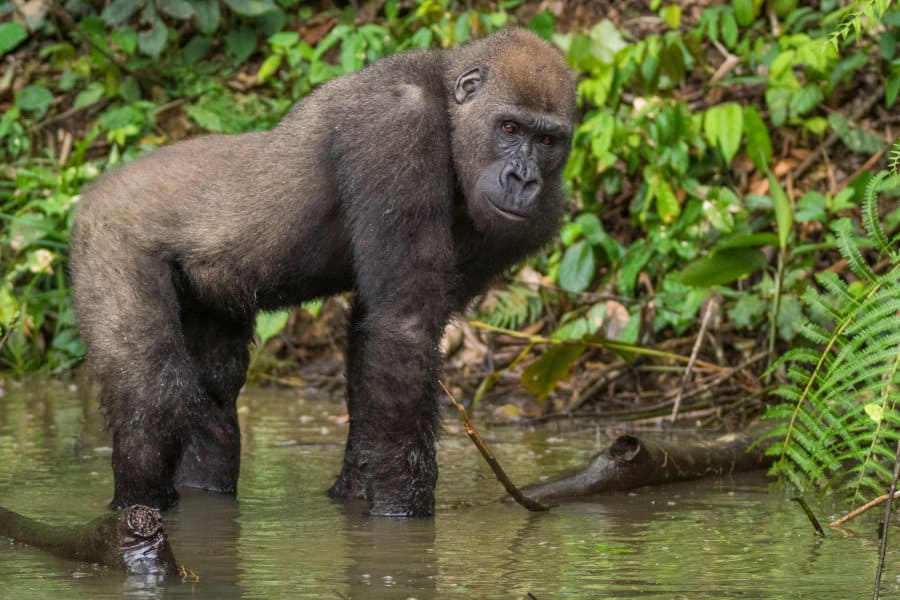It can be hard to understand why the mountain gorilla is endangered. These magnificent animals are shy, mostly keep to themselves, and can only be found in the mountains of Africa. They are also very similar to humans, so who would want to hurt them, and why?
Currently, the mountain gorilla population is at just over 1000, as of 2018. This is a feat to be celebrated after 2010’s census counted only 480 gorillas. Read on to find out why these creatures are endangered, and how we can come together to prevent complete extinction of the species.
Fascinating Mountain Gorilla Facts

- Mountain gorillas, true to their name, are found in the African mountains. They are divided into two main population groups, each inhabiting a separate region. The first group is found in Uganda’s Bwindi Impenetrable National Park. The second group lives in three protected parks in the Virunga mountains region, which spans across the Democratic Republic of the Congo (DRC), Rwanda, and Uganda.
- They usually live in groups of up to 30 and are led by elder males known as silverbacks. This name comes from the long silver stripe that develops on their backs as they age. A male is not eligible for silverback status until it reaches around 12 years of age.
- Female reproduction begins at age 10, and they will carry one or two babies at a time. Females are pregnant for around 8.5 months and will give birth to between 2 and 6 offspring in their lifetime. This slow reproductive rate doesn’t help the endangered gorillas’ population count.
- Gorillas share 98% of their DNA with humans. They also live in similar family groups and have comparable child-rearing styles. Much like humans, gorillas communicate by making different sounds.
Why is the Mountain Gorilla Endangered?

So, why are mountain gorillas endangered? Here are some of the main reasons that they are on the list of endangered animals.
1) Poached for medicine, collectors, and bushmeat
Gorillas are hunted and poached for different reasons. Often, they are killed to make traditional medicines, and their body parts are sold differently as magic charms or simply as collector items.
Another reason contributing to their endangered status is that they are hunted as bushmeat. Illegal hunters kill them to sell their meat as food.
2) Babies are captured and sold as illegal pets

Baby gorillas are captured by poachers and then sold illegally as exotic pets. Gorilla mothers are extremely protective over their young, and so the kidnapping of babies usually ends in death for the mother as well.
3) Habitat destruction due to illegal foresting trade
Illegal foresting destroys much of the gorilla’s safe habitat. This often leaves them to either migrate to more densely forested areas or to roam through areas where they are vulnerable to poachers.
The potential for oil and gas exploration in the Virunga National Park may also become a threat to the African mountain gorilla. Especially if it begins to encroach on their habitat.
4) Humans moving into mountain gorilla habitat

One of the biggest threats mountain gorillas face is their habitat being taken over by humans. People moving into the areas around the gorillas’ habitat are taking over the land and using it for agriculture and living, leaving less space for the gorillas to roam safely.
5) Civil war and unrest
Due to civil unrest in and around Virunga National Park, conservation can be difficult. At the moment, the DRC’s protected areas are in rebel-held territory, which makes protecting the gorillas almost impossible.
6) Human infections and contagious diseases
Gorillas are extremely vulnerable to human diseases. Many of them have been known to die from even the simplest cold.
Gorillas who aren’t often exposed to humans can catch infections and viruses quickly, and without having medical treatment, they are not likely to recover. The diseases also spread amongst them, causing disaster in entire troops.
Mountain Gorilla Conservation

Now we know why gorillas are endangered, but how can we prevent their extinction? There are numerous organisations that work tirelessly at conserving the gorillas’ natural habitat, keeping them safe from poachers, and guarding them against other dangers.
However, there are things that the average person can help with as well. Below are just a few ideas.
Visit the gorillas!
A fantastic way to help with the mountain gorilla’s conservation is to see gorillas in the wild. Be led by a guide through the mountains and view the animals in their home. There are also many gorilla sanctuaries where you can stay.
Book a safari in Rwanda, or go gorilla trekking in Uganda and help raise much-needed funds that will go towards conserving and protecting the endangered mountain gorilla.
Gorillas who are continuously exposed to humans, especially from a young age, are able to build their immune systems up naturally to fight off human infections. This aids in decreasing the amount of deaths caused by human diseases.
Avoid illegal log trade

The illegal log trade is a big factor in gorilla habitat destruction, and so by choosing sustainable wood products, we can hope to slow down the damage.
Donate to causes
There are many organizations that you can donate to in order to help them protect the gorillas. Find one and see how best you are able to help.
Raising Awareness

Whether you’re a die-hard animal conservationist, or simply a kind-hearted animal lover, we’re sure that one look at the mountain gorilla has convinced you they deserve our utmost attention. The great news is that the more people who become aware of the dangers they face, the easier it will become to save them.
Do your part, whether it’s taking a visit to the African mountains, donating money, or simply sharing this post to raise awareness!



